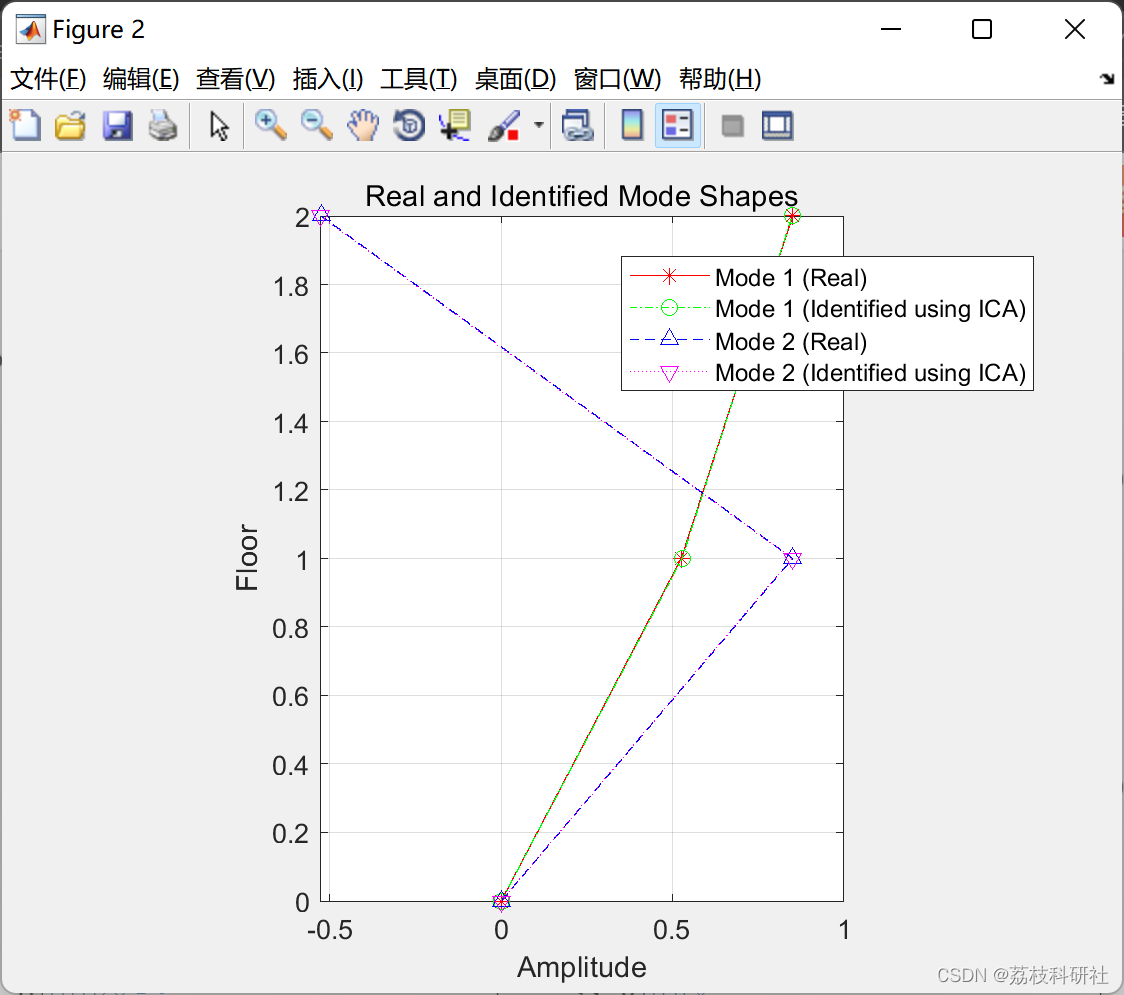基于独立分量分析进行模态分解(Matlab代码实现)
👨🎓个人主页:研学社的博客
💥💥💞💞欢迎来到本博客❤️❤️💥💥
🏆博主优势:🌞🌞🌞博客内容尽量做到思维缜密,逻辑清晰,为了方便读者。
⛳️座右铭:行百里者,半于九十。
📋📋📋本文目录如下:🎁🎁🎁
目录
💥1 概述
本文使用脉冲激励下的 2DOF 系统的独立分量分析 (ICA) 识别振型。
📚2 运行结果


🌈3 Matlab代码实现
部分代码:
zeta=Cn./(sqrt(2.*Mn.*Kn)); % damping ratio
wd=wn.*sqrt(1-zeta.^2);
fn=Vectors'*f; % generalized input force matrix
t=[0:dt:dt*steps-dt];
for i=1:1:n
h(i,:)=(1/(Mn(i)*wd(i))).*exp(-zeta(i)*wn(i)*t).*sin(wd(i)*t); %transfer function of displacement
hd(i,:)=(1/(Mn(i)*wd(i))).*(-zeta(i).*wn(i).*exp(-zeta(i)*wn(i)*t).*sin(wd(i)*t)+wd(i).*exp(-zeta(i)*wn(i)*t).*cos(wd(i)*t)); %transfer function of velocity
hdd(i,:)=(1/(Mn(i)*wd(i))).*((zeta(i).*wn(i))^2.*exp(-zeta(i)*wn(i)*t).*sin(wd(i)*t)-zeta(i).*wn(i).*wd(i).*exp(-zeta(i)*wn(i)*t).*cos(wd(i)*t)-wd(i).*((zeta(i).*wn(i)).*exp(-zeta(i)*wn(i)*t).*cos(wd(i)*t))-wd(i)^2.*exp(-zeta(i)*wn(i)*t).*sin(wd(i)*t)); %transfer function of acceleration
qq=conv(fn(i,:),h(i,:))*dt;
qqd=conv(fn(i,:),hd(i,:))*dt;
qqdd=conv(fn(i,:),hdd(i,:))*dt;
q(i,:)=qq(1:steps); % modal displacement
qd(i,:)=qqd(1:steps); % modal velocity
qdd(i,:)=qqdd(1:steps); % modal acceleration
end
x=Vectors*q; %displacement
v=Vectors*qd; %vecloity
a=Vectors*qdd; %vecloity
%Add noise to excitation and response
%--------------------------------------------------------------------------
f2=f+0.0*randn(2,10000);
a2=a+0.0*randn(2,10000);
v2=v+0.0*randn(2,10000);
x2=x+0.0*randn(2,10000);
%Plot displacement of first floor without and with noise
%--------------------------------------------------------------------------
figure;
subplot(3,2,1)
plot(t,f(1,:)); xlabel('Time (sec)'); ylabel('Force1'); title('First Floor');
subplot(3,2,2)
plot(t,f(2,:)); xlabel('Time (sec)'); ylabel('Force2'); title('Second Floor');
subplot(3,2,3)
plot(t,x(1,:)); xlabel('Time (sec)'); ylabel('DSP1');
subplot(3,2,4)
plot(t,x(2,:)); xlabel('Time (sec)'); ylabel('DSP2');
subplot(3,2,5)
plot(t,x2(1,:)); xlabel('Time (sec)'); ylabel('DSP1+Noise');
subplot(3,2,6)
plot(t,x2(2,:)); xlabel('Time (sec)'); ylabel('DSP2+Noise');
%Identify modal parameters using displacement with added uncertainty
%--------------------------------------------------------------------------
Mdl = rica(x2',n); %ICA
V=Mdl.TransformWeights;
V(:,1)=V(:,1)/sign(V(1,1));
V(:,2)=V(:,2)/sign(V(1,2));
%Plot real and identified first modes to compare between them
%--------------------------------------------------------------------------
figure;
plot([0 ; -Vectors(:,1)],[0 1 2],'r*-');
hold on
plot([0 ;V(:,1)],[0 1 2],'go-.');
hold on
plot([0 ; -Vectors(:,2)],[0 1 2],'b^--');
hold on
plot([0 ;V(:,2)],[0 1 2],'mv:');
hold off
title('Real and Identified Mode Shapes');
legend('Mode 1 (Real)','Mode 1 (Identified using ICA)','Mode 2 (Real)','Mode 2 (Identified using ICA)');
xlabel('Amplitude');
🎉4 参考文献
部分理论来源于网络,如有侵权请联系删除。
[1] Al Rumaithi, Ayad, "Characterization of Dynamic Structures Using Parametric and Non-parametric System Identification Methods" (2014). Electronic Theses and Dissertations. 1325.
[2] Al-Rumaithi, Ayad, Hae-Bum Yun, and Sami F. Masri. "A Comparative Study of Mode Decomposition to Relate Next-ERA, PCA, and ICA Modes." Model Validation and Uncertainty Quantification, Volume 3. Springer, Cham, 2015. 113-133.
相关文章
- 工具推荐|MATLAB气候数据工具箱
- matlab求两向量夹角_MATLAB基础练习(一)
- matlab axis画圆,使用MATLAB中axis实现图形坐标控制-Go语言中文社区
- MATLAB GUI的运行原理理解
- matlab逆变器仿真程序,PWM逆变器Matlab仿真「建议收藏」
- matlab条件跳出语句,if语句跳出循环
- matlab debounce,Debounce Temporal Properties
- 数值分析(一) 牛顿插值法及matlab代码
- matlab函数rand,randn,randi用法整理
- bp神经网络及matlab实现_bp神经网络应用实例Matlab
- BP神经网络预测(人口)程序(matlab)
- zigzag扫描matlab,ZIGZAG扫描的MATLAB实现
- MATLAB中plot函数功能详解[通俗易懂]
- matlab vargin_matlab varargin
- MATLAB随机波动率SV、GARCH用MCMC马尔可夫链蒙特卡罗方法分析汇率时间序列|附代码数据
- MATLAB随机波动率SV、GARCH用MCMC马尔可夫链蒙特卡罗方法分析汇率时间序列|附代码数据
- Matlab期末大作业记录(无代码版) – 学金融的文史哲小生
- 【MATLAB】数据类型 ( 执行代码 | 清空命令 | 注释 | 数字 | 字符 | 字符串 )
- Matlab基于SEIRD模型,NSIR预测模型,AHP层次分析法新冠肺炎预测与评估分析
- matlab数据如何利用MongoDB管理MATLAB数据?(mongodb管理)


